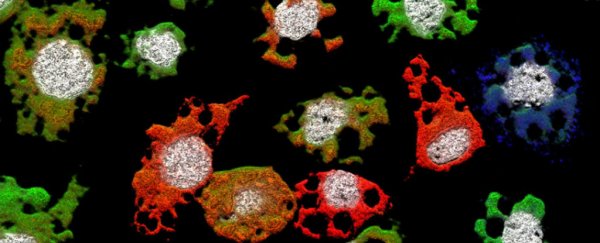A new type of virus has been identified, and it's so weird, it's challenging long-held notions of what it takes for a virus to infect and proliferate in an animal host.
Conventional wisdom states that if a single virus manages to insert its genes into a cell, the host becomes infected. But what if you chopped up that virus, and tried stuffing the pieces into an animal cell separately? It wouldn't work, right?
Well, scientists from the US Army Medical Research Institute of Infectious Diseases have just discovered the viral equivalent of a bag full of body parts, and if you throw them at a cell wall, somehow, against all odds, they stick.
"It's the most bizarre thing," virologist Edward Holmes from the University of Sydney, Australia, who wasn't involved in the study, told Michaeleen Doucleff at NPR.
"If you compare it to the human body, it's like a person would have their legs, trunk, and arms all in different places," he says. "Then all the pieces come together in some way to work as one single virus. I don't think anything else in nature moves this way."
Normal viruses are like perfectly crafted infection machines. Their genes are all neatly contained in a single viral particle that's about 100 times smaller than a bacteria cell, and its surface is so covered in spikes, it can latch onto any cell it comes into contact with.
Once a virus makes contact with a receptor on the surface of a cell, it cuts away at the outer membrane, and deposits its DNA and RNA inside.
The host's enzymes start making new virus particles based on these blueprints, and when enough replica particles have been produced, the virus kills the cell and breaks free to infect another.
Okay, now go back to the start of that scenario and cut the original viral particle into five.
That's the case for the Guaico Culex virus (GCXV) - a new type of 'multicomponent' virus that's been identified for the first time in living mosquitos.
For some reason, the genetic material of Guaico Culex has been split up into five independent packages, and in order to be infected by it, you need to be exposed to at least four different types.
"The fifth ball seems to be optional," says one of the team, Jason Ladner, adding that perhaps getting the fifth part determines how strong the effect will be on the host.
Until now, multicomponent viruses were thought to only infect plants and fungi, because their mode of transmission seems so incredibly inefficient. But now that the Guaico Culex virus has been found in several Culex mosquitos in the Guaico region of Trinidad, the question is, how many other animals could be affected by it?
While this type of virus doesn't appear to be capable of infecting mammals, the team found that they're closely related to a group of segmented viruses called Jingmenviruses, which appear to infect monkeys.
Unlike the multicomponent Guaico Culex virus, which has its genetic material separated in different packages, segmented viruses - such as the influenza virus - have their DNA and RNA segmented within a single viral particle.
Ladner and his team recently found the first evidence of a Jingmenvirus in the blood of a non-human primate - a Ugandan red colobus monkey - and while the most likely infectious viruses to make the jump to humans are those in non-human primates, it's not yet clear if all Jingmenviruses are multicomponent.
The Guaico Culex virus was discovered as part of a wider investigation by the US Army medical team to isolate mosquito-borne viruses from all over the world, in an effort to prevent epidemics like the recent spread of Zika taking researchers by surprise.
"We're trying to make sure that we're not blindsided when the next virus comes around," virologist Gustavo Palacios, who helped lead the study, wrote in a statement. "With all of the diversity seen in these emerging viruses, we never know what the next one will be to have an impact on human health."
The research has been published in Cell Host & Microbe.
